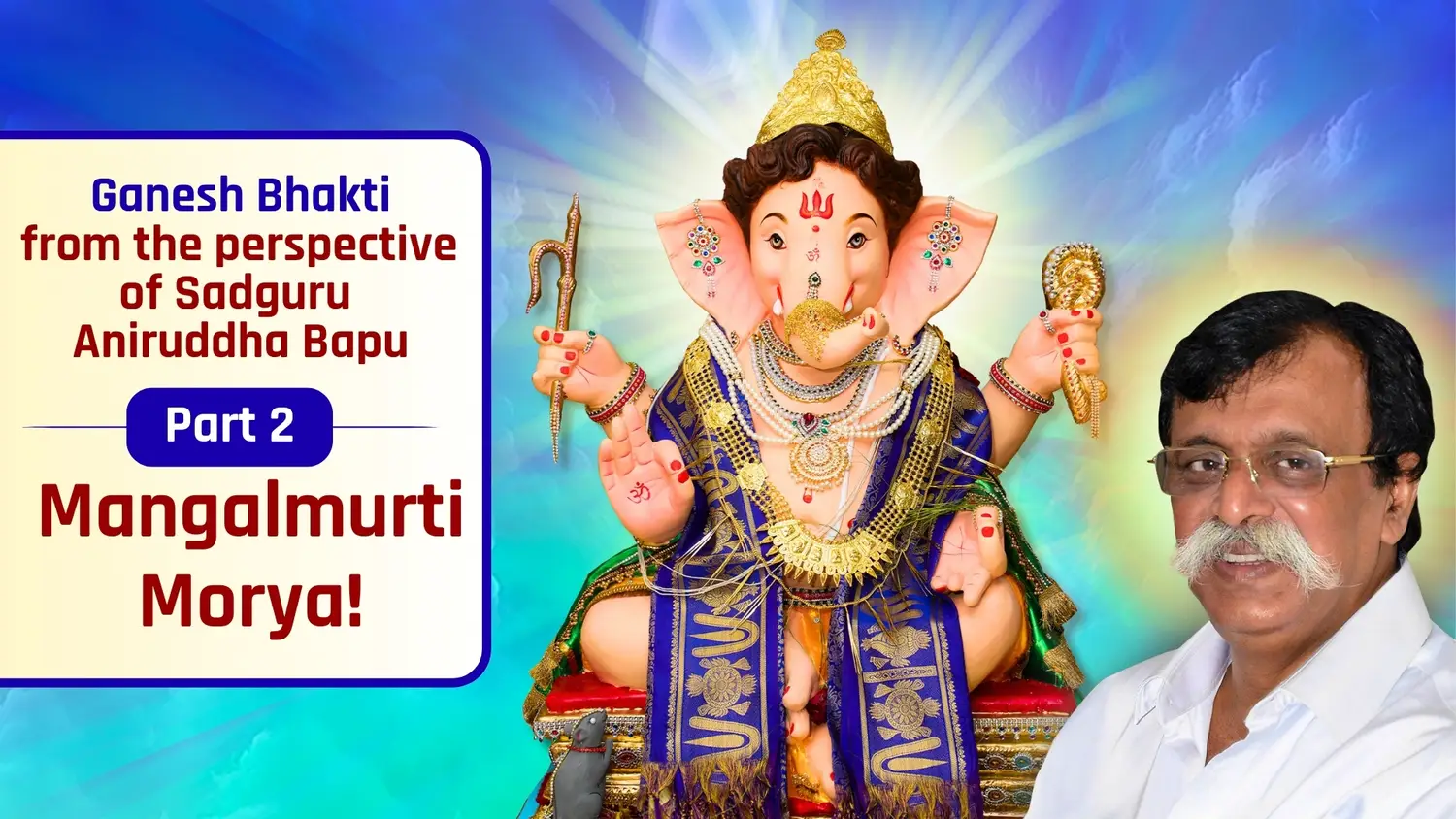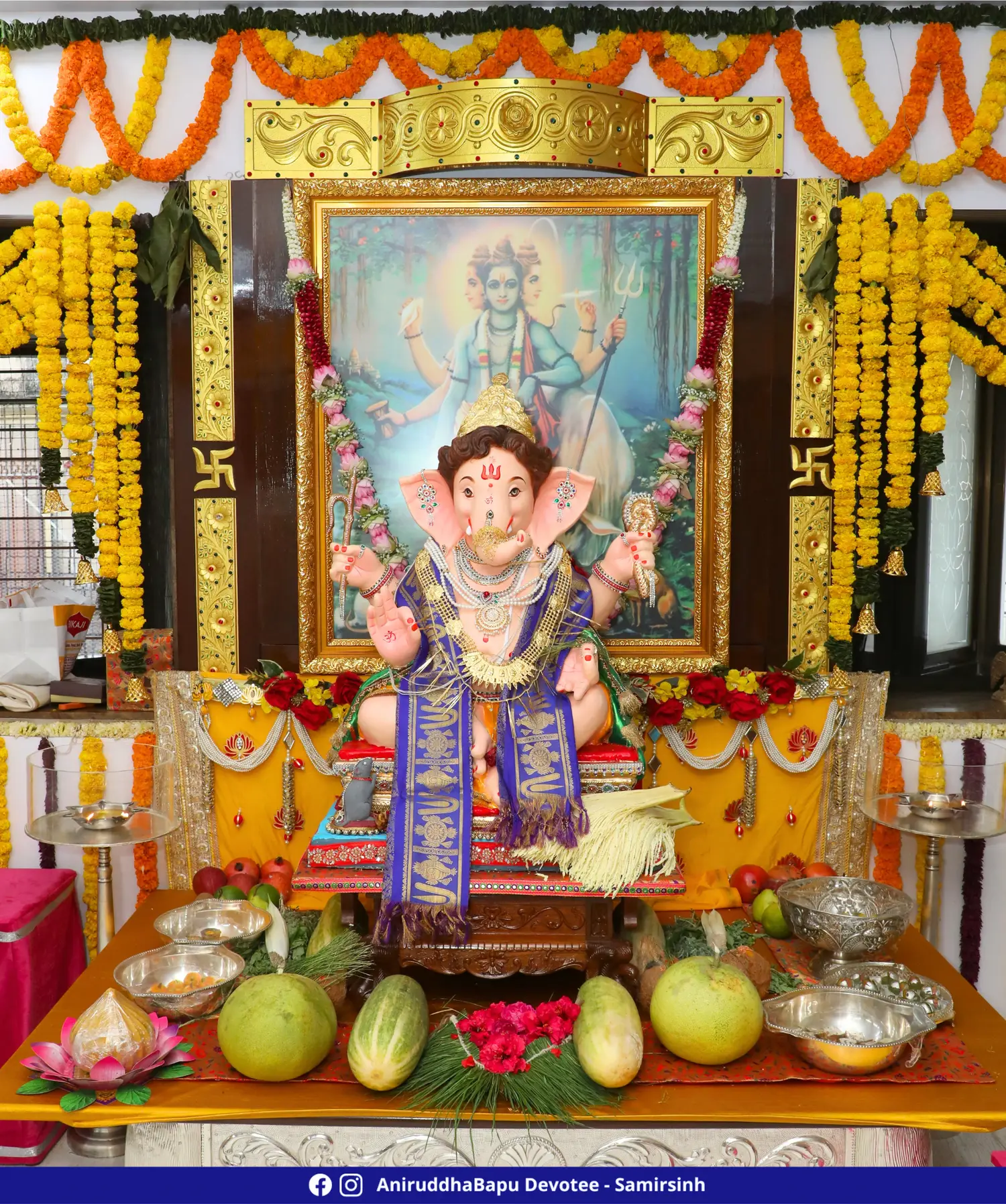Mangalmurti Morya!

मराठी हिंदी ગુજરાતી ಕನ್ನಡ বাংলা
Reference: Sadguru Shree Aniruddha Bapu’s editorial published in Dainik Pratyaksha dated 15-09-2007
Since my childhood, the atmosphere in our home has been filled entirely with pure Vedic culture, yet untouched by any traces of purity and impurity, caste discrimination, or rigid and pointless rituals. As both Mai and Aaji (my grandmother) had profound mastery over Sanskrit literature and knew all the Samhitas by heart, the pure and rhythmically precise chanting of Vedic mantras constantly graced our ears. Even today, the sweet and melodious tones of their chanting of Vedic mantras and Sooktas still resonate in my heart. The Mantrapushpanjali recited after Ganapati Aarti did not begin like today’s 'shortcut' version with 'Om Yadnyena Yadnyamayajanta...' but rather used to begin with 'Om Gananam Tva Ganapatim Havamahe...' and would go on for almost half an hour to forty-five minutes. Despite strictly following all the rules of intonation such as rise, fall, accent, and emphasis—the sweetness, softness, and natural flow of that Mantrapushpanjali remained fully alive, because the chanting was not driven by a desire to showcase superiority, but flowed from hearts blossoming with joy, drenched completely in the essence of pure devotion.
Later, when I was five years old, those two (my Mai & Aaji) taught me the proper traditional method of reciting the Mantrapushpanjali for the first time in front of the Ganapati at my maternal grandparents’ home i.e., the home of the Pandits. At that time, my mother's three aunts, along with my mother and grandmother—five women in all, performed my aukshan and lovingly fed me plenty of modaks. Back then, I was the only grandson in my maternal family, and hence, the beloved of the entire Padhye and Pandit households. That same day, Mai explained to me the family tradition of establishing the idol of Balganesh (child form of Ganesha), and thus, even today, the idol installed in our home on Ganesh Chaturthi is always that of Balganesh.

Once, I asked Mai, “Why do we always bring the idol of Balganesh every year?” Mai gently caressed my cheek and replied, “O my dear Bapuraya, when a baby comes home and is lovingly pampered and showered with affection, it naturally draws its mother and father along, and they feel pleased too. The loving adoration offered by devotees to this Bal Ganesh, invariably leads to the worship and welcome of Mother Parvati and Bhagwan Shiva as well. Nevertheless, even when we come across an adorable child of someone unknown, selfless love effortlessly springs forth in our hearts. Then, wouldn’t the bhakti and love in the heart of a devotee be just as selfless and pure in the presence of the child form of such a beautiful Mangalmurti?
These sentiments of Mai reflected the lively and vibrant tendencies of an extremely pure and sacred heart soaked in devotion. Millions of us bring the Ganapati idols and establish them at home, some for one and a half days, others for ten days. These idols may be in various forms, but do we really establish a warm, close, familial bond with this Vignantak (remover of obstacles) Ganesh? At some places, people bring Ganapati simply because they feel the tradition shouldn’t be broken; otherwise, it might invite problems. At some places, Ganapati is brought to fulfill a vow (navas), while at other places, merely for the sake of celebration and enjoyment. In the process of the establishment of idols at such places, there are mantras, Mantrapushpanjali, Aarti, MahaNaivedya (offering of food), and a meticulous effort driven by fear to strictly follow all rituals and customs. However, amidst all this bustle, what’s often lost is the very core of this worship—that is, loving devotion.
"Mangalmurti Morya" and "Sukhakarta Dukhaharta" are revered epithets of Shri Ganapati, well known to all. In fact, it is primarily because of his epithet “Sukhakarta Dukhaharta” (Giver of Joy, Remover of Sorrows) that we so readily prepare to bring Ganapati into our homes. But what about his epithet Mangalmurti (the one who brings auspiciousness)? Yes, He is indeed the Siddhivinayak and He is going to bring auspiciousness in every way. But after bringing Him home, to what extent do we actually keep Him in an atmosphere that is truly auspicious? That is the real question.
Merely placing large garlands of Durva (grass), offering 21 modaks every morning and evening, presenting red flowers, and clapping cymbals loudly during the Aartis—do we truly create an atmosphere of auspiciousness from our side, to the best of our capacity? Most of the time, the answer is ‘no’.
So, how do we offer this Mangalmurti the ‘auspiciousness’ that He expects of us? The answer is easy and simple – while welcoming the idol of Ganapati, harbour the feeling that a beloved family member is returning home after a year, place the platter filled with Naivedya (offering of food) along with twenty-one modaks before him and lovingly urge him to accept it, focus more on the worship of Ganapati than on putting on a grand show for guests. Don’t compete with anyone while singing Aartis. And most importantly, when this Mahavinayak prepares to return to his abode, let your heart overflow with emotion and make a heartfelt and rightful plea:
“Mangalmurti Morya, Pudhchya Varshi Lavkar ya” (Mangalmurti Morya, come early next year!)
At the end of the editorial, Sadguru Shree Aniruddha Bapu writes:
“My dear Shraddhavan friends, understand the true meaning of ‘Pudhchya Varshi Lavkar ya’ here. The date of his return has already been fixed. So, what could we really mean when we actually say, ‘come early’? It only means that—don’t wait until next year. O Morya, please come every day, again and again, and let that begin as soon as possible!”
